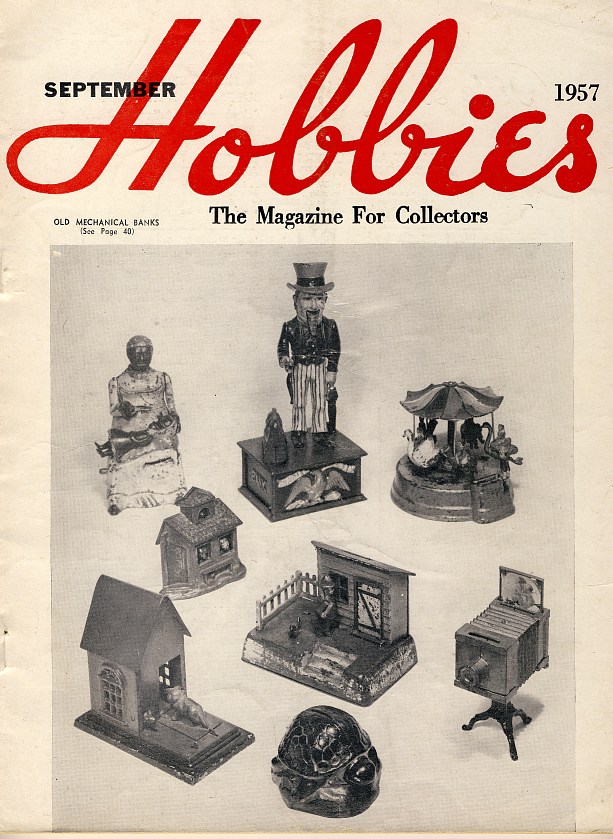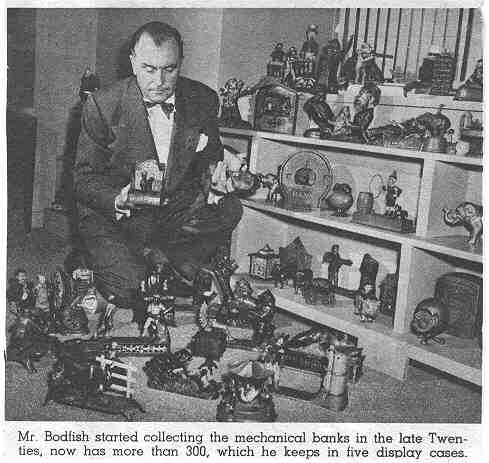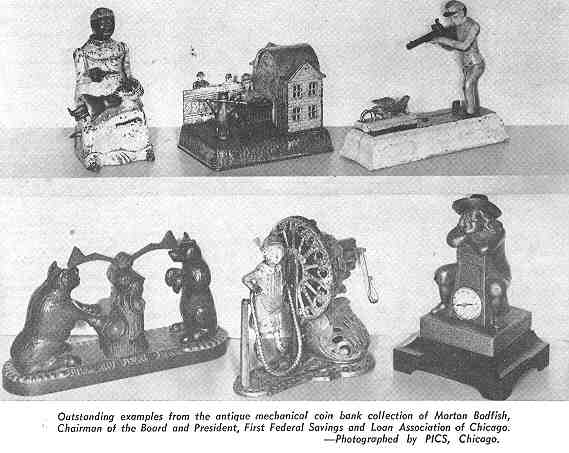BANKER BODFISH Collects Mechanical Banks



HOBBIES - The Magazine for Collectors - September. 1957

The collecting of antique mechanical toy banks is the hobby of one of Chicago's most
prominent bankers.
Today the collection of over 300 antique mechanical coin banks owned by Morton Bodfish,
Chairman of the Board and President, First Federal Savings and Loan Association of
Chicago, is one of the most outstanding and complete of its kind in the world. Every bank
is an original and is in excellent working condition.
The antique mechanical coin banks are prominently displayed in the lobby of the
Institution and also in a case on the second floor near the elevators. The rarest and most
unusual are displayed, row upon row along the book shelves in the executive offices.
"The children in olden days to encourage thrift were given, as a birthday or
Christmas present, a mechanical bank in which there was some interesting or amusing action
that dropped the penny from sight into the coin receptacle." Mr. Bodfish explains to
bank visitors.

Most of these elaborate and colorful "action" banks were
manufactured and sold from 50 to 75 years ago but they have practically disappeared today.
The idea of the mechanical banks was attributed to John Hall of Watertown, Mass., who in
1869 invented and patented the first "Hall's Excelsior" bank. When the
youngsters inserted a penny to save it for the future they were rewarded by a trick played
by the toy bank. "Hall's Excelsior" was a miniature, cast-iron house complete
with doorbell and cupola. When a child pulled the doorbell a small wooden monkey popped up
through the roof, accepted the coin and then disappeared into the house.
When these cast-iron mechanical banks were popular a few generations ago, they were
manufactured by several foundries in the Eastern part of the United States and sold for
very nominal amounts. Rising production costs, however, eventually made them almost a
luxury. Today they are so popular that avid collectors compete for the rarities and some
have traveled miles to obtain a particular bank for the collection.
Bodfish's interest in mechanical banks can't be traced like the pursuits of many hobbies
to a definite moment in his life, nor to a particular experience. As a boy in Ohio, he had
mechanical banks in the home, but his interest in them then was no more than casual. It
wasn't until he entered the financial world that these toy-like contrivances for saving
coins made a hobbyist of him.
Like other collectors of rare items, he has done his share of searching the shelves and
counters of antique shops and exploring slightly musty attics for a type of mechanical
bank he heard or read about, but did not possess. Of course, all the early vintage banks
have relative values, with the extremely rare items frequently worth a considerable sum.
Bodfish receives a great deal of pleasure from those banks which are not particularly
rare, but have interesting and unique mechanical actions or are exceptionally unusual in
design. Such mechanical banks were very popular in the past and today's market are in the
medium and low price range and still fairly easily obtained. Although he prizes also some
of his rarer specimens.
All the banks in the First Federal collection "do something." By means of
levers, springs, rollers, cranks, or other moving parts, these banks perform synchronized
movements in the process of depositing coins placed at a designated spot. Some are
extremely intricate and masterpieces of design. Banks built simply to hold coins inserted
by hand in a slot are known among collectors as "still" or "dumb"
banks. Most modern banks are of this type.
A mechanically ingenious and complex bank, in the Bodfish collection which attracts
interest especially, is the Girl Skipping Rope, advertised in old catalogues as "The
Automatic Jumping Rope Bank." The bank is set with a key, but the girl won't skip
unless a coin is deposited. When she tosses her head from side to side and skips rope as
nimbly as any little girl. The boy on trapeze is a versatile performer, but like the Girl
Skipping Rope, a mercenary one. The extent of his performance depends upon the fee paid
him. For a penny in his cap he turns once, for a nickel twice, and three times for a
quarter.
Another is the dentist who is paid by placing a coin in his pocket. As soon as he receives
his fee, out comes the patient's tooth, the patient topples over backwards in his chair
and the dentist is sent sprawling in another direction. Then there is the "Barrel
With Arms" which swallows coins pushed into the mouth of its moon face and moves its
outstretched arms gratefully. For the price of a penny Professor Pug Frog performs his
"Great Bicycle Feat," and there is the rifleman who shoots money instead of
cartridges into a slotted tree stump.
Uncle Sam, dropping coins into his carpet bag, is always good for a laugh, especially
around Federal income tax time. In his stove pipe hat, blue full-dress coat, red and white
striped trousers, leaning on his umbrella, he waits expectantly with extended hand. As
soon as he is given his stipend he drops the coin into his carpet bag and shakes his
whiskers in acknowledgment.
There are some items missing from the Bodfish collection, and like a true hobbyist, his
search goes on.
In the beginning the collecting of these little mechanical banks seemed somewhat
interesting but during the years has become to this collector one of the most fascinating
and entertaining of hobbies. The mechanical bank collectors of today are helping to
preserve a delightful section of our heritage - of Americana.
